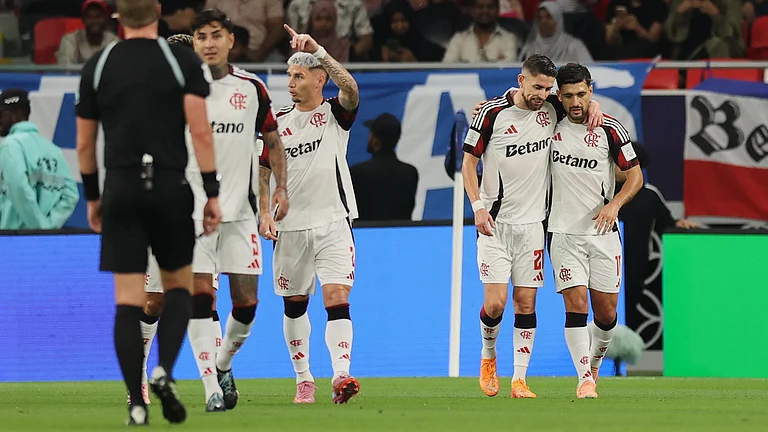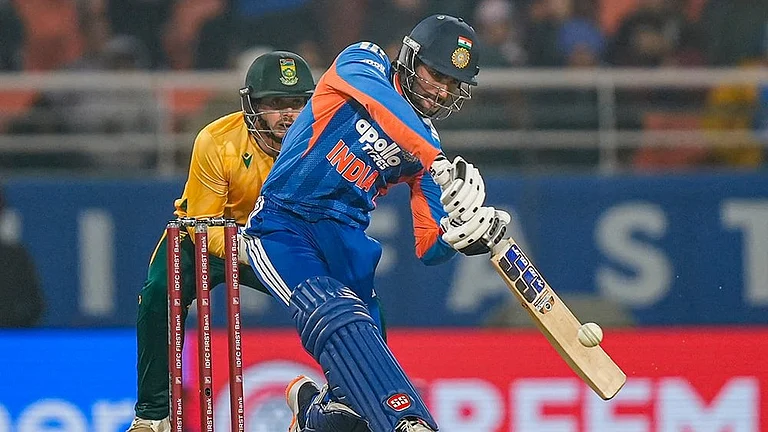Cricket trickled down to Indians through the colonial British upper classes in Bombay, but Indians inherited the leather orb that rules the world of sport from English privates—a proletarian game then, as now—in Calcutta. Its popularity soared in the second half of the 19th century and the city and towns in West and (erstwhile) East Bengal fairly bristled with football clubs, none more famous than Mohun Bagan (est 1888), one of the oldest in the world. Football was extolled for its manly, vigorous virtues, and its rise in Bengal was effectively analogous to the rise of the revolutionary secret societies. Nationalism was in the genes of Indian football and it gained momentum following Mohun Bagan’s historic win in the IFA Shield Final in 1911 against East Yorks—a British army side. Calcutta attracted football talent from all over the country, particularly from East Bengal, and hosted top football tournaments—Calcutta Football League, IFA Shield, Cooch Behar Cup, Trades Cup etc.
It was the raw deal meted out to players from East Bengal—a people, though Bengali, distinct in dialect, food, custom and perceived nature—which led to the birth and rise of East Bengal Club, now in its centenary year. Its rise is an inspiring tale of a marginalised section asserting itself and fighting to secure its rightful place in Calcutta’s maidan.

A procession with the club flag celebrates its centenary.
Derided for long by privileged babus in Calcutta, discrimination against East Bengali footballers reached a nadir in a Cooch Behar Cup semi-final on July 28, 1920, when two players, Ramesh Sen and Sailesh Bose, were unfairly dropped from the Jorabagan Club team in their clash vs Mohun Bagan. This proverbial last straw prompted Jorabagan vice president Suresh Chandra Chaudhury to form a club—East Bengal, where Bengalis from across river Padma could ply their skills with honour. Chaudhury drafted his friend, renowned advocate Tarit Bhushan Roy, into the venture.
The first tournament East Bengal competed in was the Hercules Cup—a six-a-side competition. In due course, East Bengal became a member of the IFA’s governing body and started their campaign in the second division of Calcutta Football League in 1921. A long journey had begun, and success was almost instantly achieved.
Set up and manned by proud people who were fighting for every inch of turf in the metropolitan centre, East Bengal quickly cemented a reputation of doggedness and a fearless attacking style. Prejudiced ‘Calcatians’ were to be taught a lesson and players took frequent swigs from the bottled-up passion when they took the field.

A Bagan defender in action in 2001.
That spirit was patently visible when the club was promoted to first division of the CFL in 1925. In the first ‘derby’ clash with arch-rivals Mohun Bagan—the preferred club of those insufferable tormentors, the Calcutta elite—on May 28, emotions ran high. With a stronger team Bagan was dominant, but E. Bengal goalkeeper P. Das warded off numerous goal-bound sallies. Much against the run of play, left-winger Nepal Chakravarty scored a goal and East Bengal hung on to that lead. That win sparked a rivalry which continues to this day. Hundreds of EB fans, punch-drunk with pride, invaded the ground after the match and carried off the players on their shoulders. The match also set the pattern of future derby clashes, where East Bengal was the more aggressive side and dominated their rivals.
The ‘fighting spirit’ of East Bengal became a byword, and a derby clash was designated as a day of battle. The result closest to East Bengal’s heart was its crushing 5-0 triumph over Mohun Bagan in the 1975 IFA Shield final. Still the biggest derby win, it remains a watershed moment in the annals of the club. It gave EB fans bragging rights for eternity, it seemed, and forced upon Bagan its own Maracanazo—a shock that lingers to this day.

A derby clash from the 1930s.
If the club embodied a consolidation of regional identity in the early decades, Partition gave it a further purpose: to the millions of battered and immiserated refugees fleeing what became East Pakistan, the club offered a direly needed symbolic salve. Footballing excellence resulted in pride, hope and confidence for a dispossessed, hapless generation. Loss of home and hearth forged a fervid credo of defiance in the teeth of odds that fans infused the club with and demanded of its players. Like passion from the favelas made up the life-blood of the Brazilian team, fanatical support from the ‘refugee colonies’ sustained East Bengal for decades. Fittingly, it was during this period that East Bengal was at its rampaging best. In the ’40s and ’50s, the club won a staggering 21 trophies. From 1949-53, it was spearheaded by the ‘Pancha Pandavas’—a lethal forward line, comprising Ahmed Khan, Apparao, P. Venkatesh, P.B. Saleh and Dhanraj, that was the terror of teams across India and has now passed into legend, even myth.
As the scars of Partition healed, the once unbreachable East-West divide dissolved, leaving a sediment of mild, mutual ribbing and drollery. Yet, the football rivalry endures in Bengali consciousness, a part of the milieu. Till the mid-eighties, the last great period of maidan football, the metropolis tensed up in brooding anticipation on the day (often on a Saturday) of a derby clash, neatly divided into opposing camps, a division that ran through localities, friend circles, even families. Indeed, once the proud name of the bigger landmass of the undivided province, ‘East Bengal’ lives on only in the name of this great institution.

The first Mohun Bagan-East Bengal face-off on May 28, 1925.
Uniquely, the fan base of East Bengal covered the widest possible social arc—from refugees selling vegetables to the gentry and business houses with roots in erstwhile East Bengal. Celebrity fans were present in good force too—the legendary father-son composer duo of Sachin Dev Barman and Rahul Dev Barman prominent among them. Every time East Bengal played in the Rovers Cup in Bombay, SD would not let the team leave for a match until he had ritually touched every player’s shoulder. In 1975, the inimitable S.D. Burman slipped into a prolonged coma. After East Bengal dealt its famous 5-0 blow to Mohun Bagan, rumour spread that SD’s body responded when R.D. Burman brought home the news of the victory. The red and gold club jersey inspired many such tales of fanatical support.
The club’s roster is a who’s who of great footballers, from pioneer attackers like Somana, Sunil Ghosh and Ahmed Khan in the ’40s and ’50s to forwards Surajit Sengupta, Shyam Thapa, P. Sinha, Parimal Dey, Subhash Bhowmik; defenders Ram Bahadur and Sudhir Karmakar in later decades. The list gets a golden tinge with the addition of the sublime goal-scoring of Tulsidas Balaram, Sukumar Samajpati and the great Iranian Majid Bishkar, the magical mid-field skills of Krishanu Dey and the exploits of Bhaichung Bhutia. A lateral section of Indian football history lies on those boards.

EB’s Shyam Thapa hammers in another nail in the 5-0 demolition of Mohun Bagan in the 1975 IFA Shield final.
East Bengal is the only club team with three players—Ahmed Khan (1952), J.Kittu (1956) and Balaram (1960)—to have scored for India in the Olympics. Bhaichung has scored the maximum goals (49) for the club in the NFL/I League. It was the first Indian club to send a team on an official tour to Europe in 1953 and was the only Indian team invited to feature in a tournament hosted by Leicester City. It was also the first Indian outfit to notch a win against a foreign team when they defeated the Chinese Olympic team 2-0 in 1948. In Moscow, they held Moscow Torpedo—a top European side then—3-3 in a tour match in 1953. East Bengal was also the first team to win the IFA Shield by defeating a foreign team when they pipped Pas Club (Iran) 1-0 in 1970. The club added another trophy to their cabinet when they won the LG Asean Club Cup in Jakarta in 2003.
In its hundredth year, the club management has drawn up an ambitious commemorative plan starting August 1. Noted film-maker Goutam Ghose is working on a documentary on the club’s various achievements, highlighting East Bengal’s role in the upliftment of refugees around Partition. Prominent people are taking up their pens to contribute to a centenary volume. All surviving EB captains will be felicitated and a football tournament involving leading clubs will mark the occasion. Memories of great players, matches, wins and losses sustain a people’s sporting annals. East Bengal, in addition to that, is the bearer of a significant, tormented slice of Bengal’s social history.
***
The Honours That Make Up The Halo
First Indian team to beat a foreign team at home when they defeated China’s Olympic Team 2-0 in 1948. Goals by Appa Rao and Saleh.
First Indian team to win IFA Shield three years in a row: 1949-51
First Indian team to Europe (USSR and Romania) in 1953
First Indian team to win IFA Shield defeating a foreign team when they defeated Pas Club (Iran) 1-0. Goal was scored by Parimal Dey.
E. Bengal beat Mohun Bagan 5-0 in the 1975 IFA Shield Final—highest margin of victory in Derby clashes.
East Bengal won the CFL from 1970-75, eclipsing Mohammedan Sporting’s record of five consecutive wins (1934-38). EB bettered this by winning the CFL eight years in a row, from 2010 to 2017.
Won all 5 trophies in 1972, conceding only four goals through the season. The trophies won were CFL, IFA Shield, Bordoloi Trophy, Durand Cup, Rovers Cup (Joint).
East Bengal won the National Football League (NFL) for the first time in 2000-01 and repeated the triumph in 2002-03 and 2003-04.
It won the ASEAN Club Cup in Jakarta in 2003, defeating Bec Terro Sassana (Thailand) 3-1 in the final.Goals scored by Mike Okoro, Bhaichung Bhutia, Alvito D’Cunha. The only Indian team to qualify for the semi-final of AFC Cup, remaining unbeaten in 2013.
By Gautam Roy in Calcutta





















